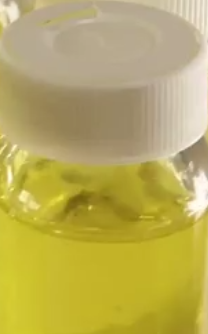| "Descrizione" by Carnob (1982 pt) | 2023-Jul-26 18:14 |
Review Consensus: 8 Rating: 8 Number of users: 1
| Evaluation | N. Experts | Evaluation | N. Experts |
|---|---|---|---|
| 1 | 6 | ||
| 2 | 7 | ||
| 3 | 8 | ||
| 4 | 9 | ||
| 5 | 10 |
Hexyl cinnamal is a chemical compound derived from cinnamaldehyde and is obtained from octanal and benzaldehyde or by esterification of hexyl alcohol with cinnamic acid. It can be obtained from natural sources where it is a minor constituent of essential oils of jasmine (Jasminum L.), cinnamon (Cinnamomum verum, Cinnamomum zeylanicum Blume), chamomile (Matricaria recutita).
The name describes the structure of the molecule:
- Hexyl refers to a six-carbon chain that is attached to the rest of the molecule. Hexyl groups are often used in organic chemistry to change the properties of a compound, such as its solubility or reactivity.
- Cinnamal is an abbreviated form of cinnamaldehyde, which is the organic compound that gives cinnamon its taste and smell. In the context of Hexyl Cinnamal this part of the molecule is responsible for the fragrance.
The synthesis process takes place in different steps:
- Preparation of starting materials. The first phase begins with two primary ingredients: hexanal and cinnamaldehyde. Hexanal is an aldehyde with a six-carbon chain, and cinnamaldehyde is an aromatic aldehyde derived from cinnamon oil.
- Aldol Condensation. The next step is an Aldol condensation reaction. In this reaction, hexanal and cinnamaldehyde are placed under specific conditions to form a larger molecule. This reaction typically requires a basic catalyst and heat.
- Purification. The final stage of the synthesis process involves the removal of unreacted materials and by-products from the reaction mixture to obtain pure hexyl cinnamal.
It appears as a colourless to yellowish liquid with a strong, sweet odour.

What it is used for and where
Cosmetics
It is a restricted ingredient as III/87 a Relevant Item in the Annexes of the European Cosmetics Regulation 1223/2009. Ingredient at risk: 2-Benzylideneoctanal. The presence of the substance must be indicated in the list of ingredients referred to in Article 19(1)g when its concentration exceeds:
- 0.001% in leave-on products
- 0.01% in rinse-off products
A perfume that is added in cosmetics to liquid soaps, shampoos and more.
Perfuming. Unlike fragrance, which can also contain slightly less pleasant or characteristic odours, the term perfume indicates only very pleasant fragrances.
Applications
Fragrance Ingredient in Cosmetics: It's a common component of fragranced cosmetics and personal care products. Examples include lotions, shampoos, conditioners, shower gels, and many other products.
Perfumes: Due to its jasmine-like scent, hexyl cinnamal is widely used in perfumes either as a primary note or a secondary one to enhance other aromas.
Soaps and Detergents: It is sometimes used to impart a pleasant fragrance to soaps, detergents, and cleaning products.
Candles and Air Fresheners: Hexyl cinnamal can also be found in scented candles, room sprays, and other home fragrance products.
Hair Care Products: The pleasant scent of hexyl cinnamal makes it a sought-after ingredient in hair care formulations, such as hair sprays, serums, and mousses.
After Shave and Cologne: Men's grooming products, like after shaves and colognes, can also contain hexyl cinnamal as a fragrant ingredient.
Most significant studies
Hexyl cinnamal has shown, in scientific studies, low ability to induce skin sensitization (1), overall, a product that can be used several times a day (2).
α-Hexylcinnamaldehyde (HCA), a compound derived from cinnamaldehyde, was evaluated for its potential chemosensitizing properties. In spite of a low cytotoxicity, HCA increased the antiproliferative effect of doxorubicin in all the cell lines tested, being particularly effective in CCRF/CEM. The compound also reduced the rhodamine123 efflux in Caco-2 and CEM/ADR5000 cells, suggesting a possible interference with ABC transporter functionality (3).

- Molecular Formula: C15H20O
- Molecular Weight: 216.32 g/mol
- CAS: 101-86-0
- UNII: E9947QRR9O
- EC number: 202-983-3
Synonyms: alpha-Hexylcinnamaldehyde,HCA, HEXYL CINAMIC ALDEHYDE, CYCLOHEXYL-2-PHENETHYL KETONE, 3,3-dimethyl-5-tert-butyl-2H-inden-1-one, 1- (4-cyclohexylphenyl) -1-propanone
References______________________________________________________________________
(1) Basketter D, White IR, McFadden JP, Kimber I. Hexyl cinnamal: consideration of skin-sensitizing properties and suitability as a positive control. Cutan Ocul Toxicol. 2015;34(3):227-31. doi: 10.3109/15569527.2014.933973..
Abstract. Background: Hexyl cinnamal (HCA) is a widely used fragrance chemical, the low skin-sensitizing potency of which has made it a common choice for the use as a positive control for predictive toxicology assays. However, HCA is commonly negative in current candidate in vitro alternatives testConclusions: Using GHS criteria (and applying a precautionary approach) HCA would classify as a weaker skin sensitizer than predicted by the local lymph node assay (LLNA). However, given the human experience, it is necessary to consider whether HCA is the most appropriate choice for use as a positive regulatory control.
(2) Yazar K, Johnsson S, Lind ML, Boman A, Lidén C. Preservatives and fragrances in selected consumer-available cosmetics and detergents. Contact Dermatitis. 2011 May;64(5):265-72. doi: 10.1111/j.1600-0536.2010.01828.x.
(3) DI Giacomo S, DI Sotto A, El-Readi MZ, Mazzanti G, Wink M. α-Hexylcinnamaldehyde Synergistically Increases Doxorubicin Cytotoxicity Towards Human Cancer Cell Lines. Anticancer Res. 2016 Jul;36(7):3347-51.
| Evaluate |

